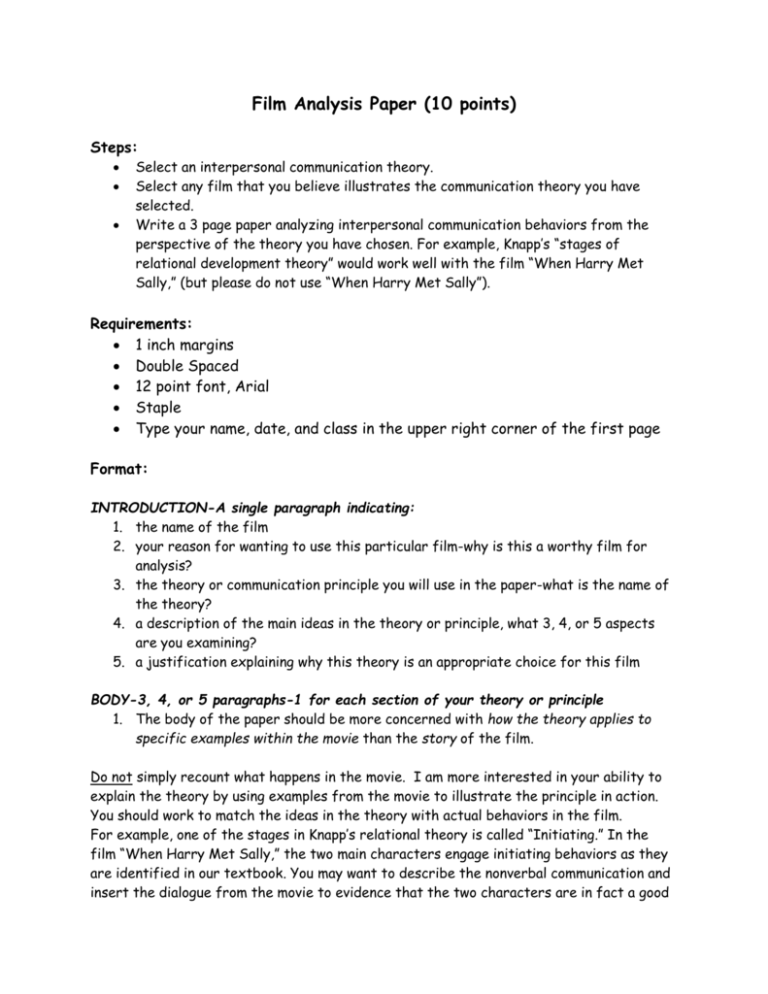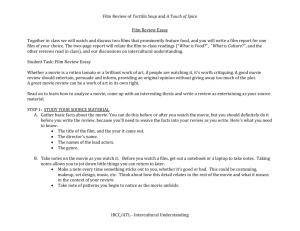Interpersonal Film Analysis Paper
advertisement

Film Analysis Paper (10 points) Steps: Select an interpersonal communication theory. Select any film that you believe illustrates the communication theory you have selected. Write a 3 page paper analyzing interpersonal communication behaviors from the perspective of the theory you have chosen. For example, Knapp’s “stages of relational development theory” would work well with the film “When Harry Met Sally,” (but please do not use “When Harry Met Sally”). Requirements: 1 inch margins Double Spaced 12 point font, Arial Staple Type your name, date, and class in the upper right corner of the first page Format: INTRODUCTION-A single paragraph indicating: 1. the name of the film 2. your reason for wanting to use this particular film-why is this a worthy film for analysis? 3. the theory or communication principle you will use in the paper-what is the name of the theory? 4. a description of the main ideas in the theory or principle, what 3, 4, or 5 aspects are you examining? 5. a justification explaining why this theory is an appropriate choice for this film BODY-3, 4, or 5 paragraphs-1 for each section of your theory or principle 1. The body of the paper should be more concerned with how the theory applies to specific examples within the movie than the story of the film. Do not simply recount what happens in the movie. I am more interested in your ability to explain the theory by using examples from the movie to illustrate the principle in action. You should work to match the ideas in the theory with actual behaviors in the film. For example, one of the stages in Knapp’s relational theory is called “Initiating.” In the film “When Harry Met Sally,” the two main characters engage initiating behaviors as they are identified in our textbook. You may want to describe the nonverbal communication and insert the dialogue from the movie to evidence that the two characters are in fact a good illustration of the theory. At times, the movie will actually stretch our understanding of a theory, which you may also want to explore to deepen your analysis. With some theories, it may be necessary to “group” the principles into 3, 4, or 5 more manageable main ideas. For example, Knapp’s theory has 10 parts. You probably would not be able to develop 10 points well in a paper of this length. Some of the points may be more appropriate than others for analysis, so pick and choose. It might also be a good idea to see if the parts of the theory can be grouped together. CONCLUSION-A single paragraph including: 1. a summary of the main ideas that you have covered in your paper 2. a description of what you learned from viewing the film for this paper in this manner 3. a explanation of how you might apply this information to your own life 4. a assessment of what others might learn from your analysis Tips: Select a good quality movie that you can access and see a couple of times. Select 3 scenes to analyze and make sure that you either incorporate the dialogue from them or thoroughly describe them to evidence the connections you are making about the film and theories. It is easier to analyze theories that contain multiple parts. Some theories we have discussed or will discuss that might work well are: Perception: The steps in the perception process Emotions: Types of emotional responses, cultural difference Context: Social, temporal, psychological, physical conversational levels: cliché, fact, opinion, feeling Self-concept: Reflective appraisal vs. social comparison, life-scripts, changing selfconcept Listening: Steps in active listening, types of ineffective listening, becoming a better listener Non-verbal: Hall’s four zones of space and territory Climate: Confirming vs. disconfirming climate Assertiveness: Non-assertive, aggressive, assertive behavior, passive aggression Transactional analysis: ego states, games Relationships: Knapp’s stages of relational development Conflict: Win/lose vs. win/win orientation, steps to no-lose solutions, conflict spirals





